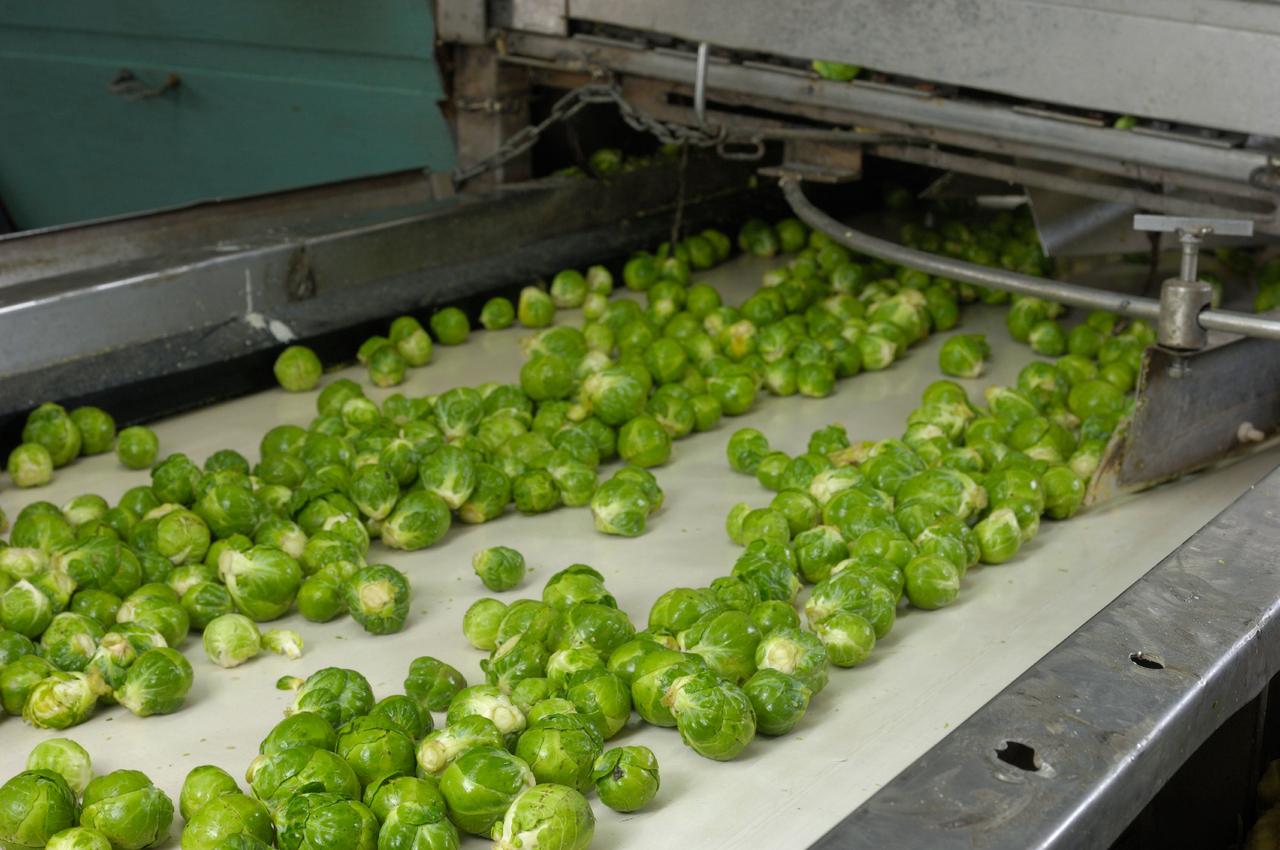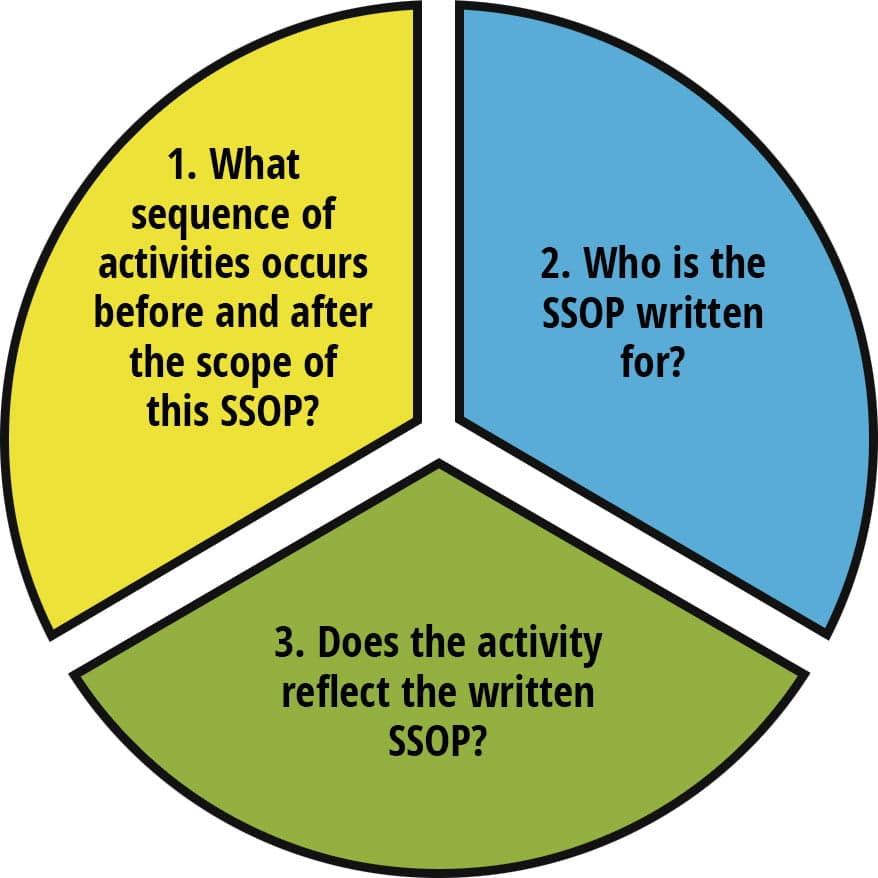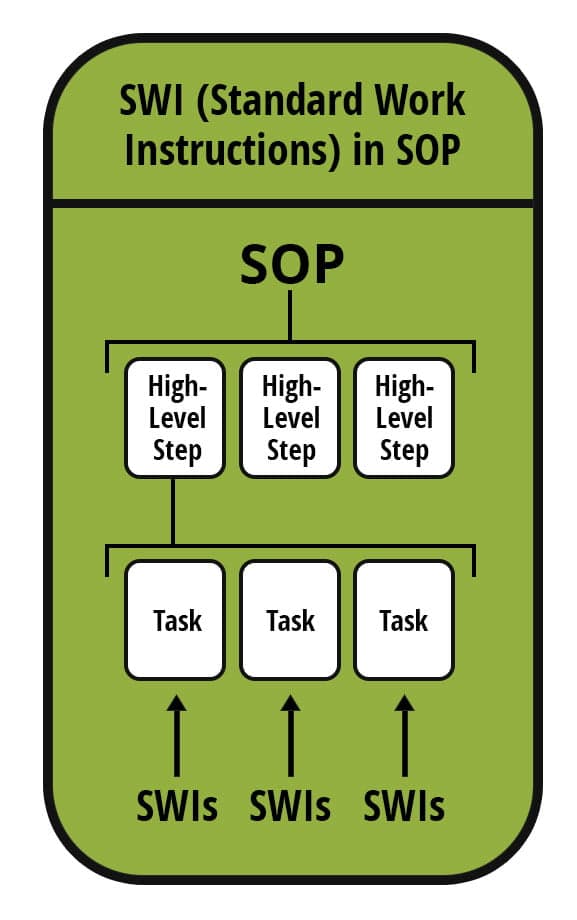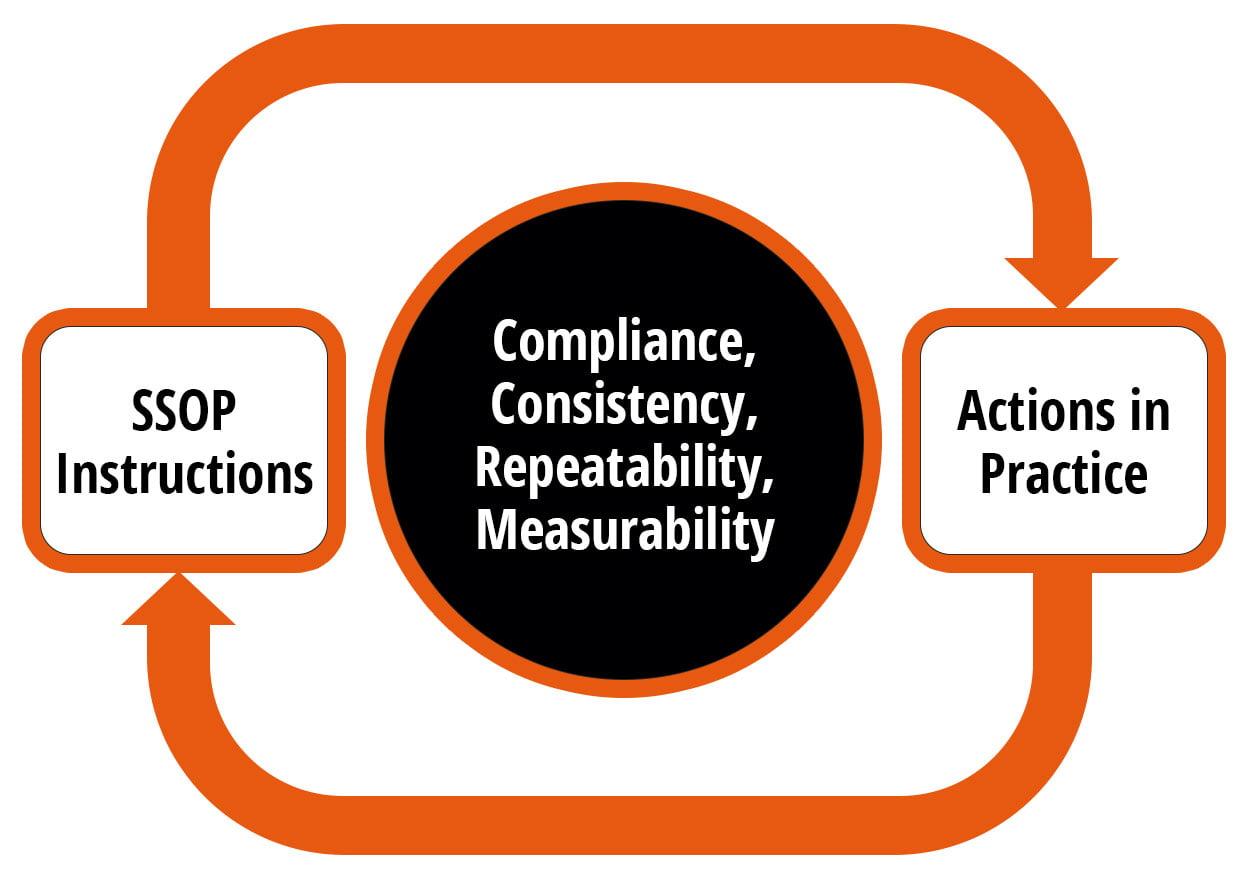SANITATION
By Angela Anandappa, Ph.D.
Why SSOPs Are the Foundation of a Well-Functioning Food Safety Program
Key elements of Sanitation Standard Operating Procedures

Photo credit: GomezDavid/E+ via Getty Images
SCROLL DOWN
Standard Operating Procedures (SOPs) are instructions used to facilitate how employees perform complex tasks routinely. SOPs allow the task, when performed as stated in the SOPs, to deliver consistent quality uniformly and, by doing so, reduce products that don’t conform to company policies or quality standards and help comply with relevant regulatory requirements. Almost any food safety training program will refer to sanitation processes as a prerequisite for food production and Sanitation SOPs (SSOPs) as essential to those activities. This makes good SSOPs a foundational element of a competent food safety program.
The Compliance Connection
SSOPs are an important part of the U.S. regulatory requirements and crucial for fulfilling the record-keeping requirements for food safety. Sanitation controls are part of the prerequisite programs for Hazard Analysis and Critical Control Points [HACCP; Title 21 of the Code of Federal Regulations (C.F.R.), Part 120] that specify the requirement for a processor to implement SSOPs to have a good understanding of the sanitary conditions and practices at three specific stages: before, during, and after processing.
Plants operating under the jurisdiction of the U.S. Department of Agriculture Food Safety and Inspection Service (USDA-FSIS) are expected to comply with 9 C.F.R. Part 416 in combination with 21 C.F.R. Part 178.1010. Together, these regulations require SSOPs for sanitation procedures that are part of the prerequisite programs for HACCP. But far beyond the USDA requirement, good SSOPs are not only necessary but also could be considered important in efficiency. Let’s look closer at why that is, as well as review some strategies for implementing and using the best approaches possible.
USDA-FSIS inspection is a requirement for producing a saleable product, and uninspected product is subject to recall if it does enter the market. Therefore, it is important to note that FSIS may refuse to grant federal inspection of a facility if SSOPs are not available or if the facility has not demonstrated that adequate sanitary conditions exist. These are both required under 9 C.F.R. Parts 417 and 416, respectively. Global Food Safety Initiative standards also require that procedures be in place for ensuring the hygienic conditions of the plant, equipment, utilities, personnel, ingredients, additives, and other elements, along lines similar to U.S. regulatory requirements and overlapping those of many countries around the world.
A Web of Documentation
SSOPs help ensure the hygienic condition of all things, people, and materials that may intentionally or unintentionally come into contact with the food or be part of the food. Aside from the ingredients and the food itself, there must be a plan for ensuring that the equipment, water and air, utensils, and any other items used in the facility are of suitable hygienic condition before, during, and after the food is processed or handled. Personal hygiene and health conditions of employees are included in the SSOP requirements set forth under Title 21, Part 120 Subpart A.1,2 The list calls out several specific areas that overlap the documentation required as part of other quality programs and U.S. Environmental Protection Agency requirements, or that might cross over into U.S. Occupational Health and Safety Administration expectations for safety and employee health and wellness. This can make for a complex web of documents and requirements, not to mention a certain degree of duplication. Here lies the opportunity to look closer at both efficiency and operational accuracy while running an effective food safety program.
With this background laid out, Figure 1 depicts three important questions to consider.

FIGURE 1. Three Questions That Will Improve Your SSOPs
1. What sequence of activities occurs before and after the scope of this SSOP?
Knowing which aspects of the “flow” are connected to the scope of the SSOP can determine why the timing, materials, frequency, etc., of the SSOP need to be conducted the way it specifies. For instance, a fresh-cut or produce-packing operation may pay particular attention to the SSOPs before and after cutting fresh produce and have specific temperature requirements for the wash water used. Similarly, deli slicing operations might have a frequent, rhythmic cleaning protocol that compartmentalizes risk associated with cutting the slices. The documentation trail for this frequency may carry the scrutiny of product spoilage investigations or even be the control point that limits potential metal shards from entering the product. The temperature of the room and the water used could be important in how rapidly soils are emulsified and carried away or lead to drain backups when mixed with the wrong sequence of products.
“SSOPs are an important part of the U.S. regulatory requirements and crucial for fulfilling the record-keeping requirements for food safety.”


Anatomy of an SSOP
Key elements of SSOPs include the following general framework: a documented description of the scope of the SSOP, equipment, personnel involved, responsibilities for duties, a description of the specific duties, materials, protocols and products used, frequency of activities, detailed and specific instructions for conducting the activities, and record keeping for all the above. Several food examples of the important elements of an SSOP can be found through local research universities or through specific programs that help walk processors through HACCP training and identifying the steps where an SSOP is necessary.3,4
2. Who is the SSOP written for?
Documents should exist for tracking and running a business more effectively and efficiently. But when it comes to work instructions like those that are part of an SSOP, they also share the burden of being viewed through the lens of compliance and for processes other than the core of the work being performed. The personnel most likely to actually use the SSOP are operators who conduct their work as described in the SSOP, making the operator(s) the audience for whom the work instructions are written. There may be more than one person involved or several who share the work sometimes over different shifts. A quick test of whether your SSOPs are designed properly is to have a new operator perform the job precisely as described in the work instructions.
It is easy to look at an SSOP and not see what is missing. There are numerous reasons why SSOPs might be overlooked, but let us, for a moment, assume they have not been overlooked and you are interested in improving them. In that case, there are a few ways to evaluate the robustness of the SSOPs and take measures to improve them. For example, an internal audit scenario could be an appropriate method of testing whether the work instructions in the SSOP, the actual work performed, and the work needed are in alignment. If the SSOP is implemented, it will have more opportunities to be questioned for updates based on circumstances or in response to abnormal situations. An SSOP document that has not changed for many years should be verified for its relevance and validated to current practices. Often, a change in ingredients, change in cleaning suppliers, maintenance updates, or even the average height of the operator performing the duties might influence an SSOP. Asking the operator to question and make sure they have all they need in written, oral, and visual formats in the relevant native language(s) used by the operator(s) is important to the validity and effectiveness of the SSOP.

FIGURE 2. Standard Work Instructions for Each Task Are Important Elements of SSOPs
3. Does the activity reflect the written SSOP?
Time studies and observation of work as it is performed are frequently used methods by practitioners of Lean operations. We use this approach in SSOP verification, and in testing the robustness of work instructions relating to all matters of food safety, this can be enlightening. An important tool used in these measures relies on measuring “standard work instructions” (SWIs). SWIs refer to specific, well-defined work procedures that are performed repeatedly. The difference between SWIs and other work instructions is the delivery of consistency every time. These SWIs (Figure 2) are the bedrock of any activity being a candidate for continuous improvement by adopting observation, measurement, and then systematic improvement.
When you ask yourself, “Does the activity reflect the written SSOP?” the answer and how you obtain it in a systematic way will make the difference between obtaining the correct answer and simply getting the easy answer. Observing and measuring SWIs takes time, planning, and method. Reconciling instructions with practices will guide employee training and serve as a check on the SSOPs and the systems in place at a very granular level. In essence, if the written instructions align with the actions being taken (Figure 3), then the SSOP is valid. If they do not, the SSOP needs to be reworked and updated to reflect the correct procedure and not a theoretical procedure or the lowest common practice.

FIGURE 3. Documents Must Reflect Actions
Finally, SSOP evaluations are difficult to conduct, as desk audits and reviews would be better performed on-site, failing which cameras and videography are helpful tools. Essentially, with these three questions in mind, reviewing, observing, and systematically measuring SSOPs will deliver better SSOPs that are compliant, consistent, measurable, and repeatable.
Angela Anandappa, Ph.D., is the founding executive director of the nonprofit Alliance for Advanced Sanitation, an organization focused on improving food safety.

